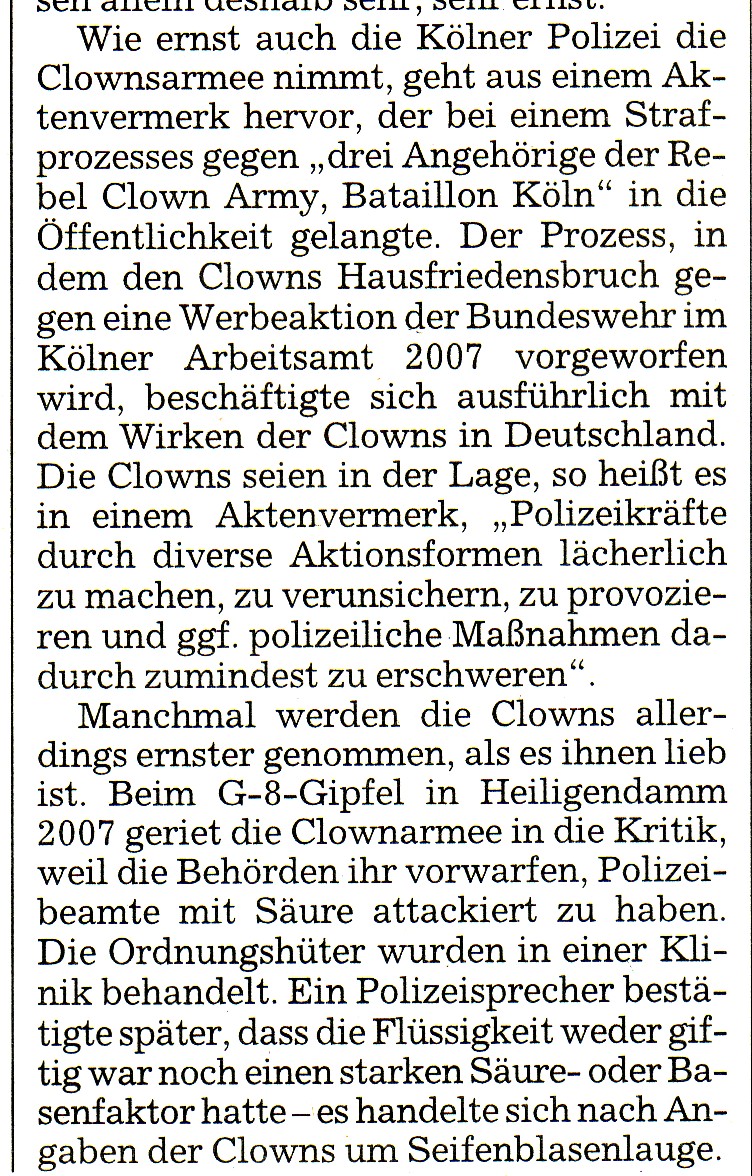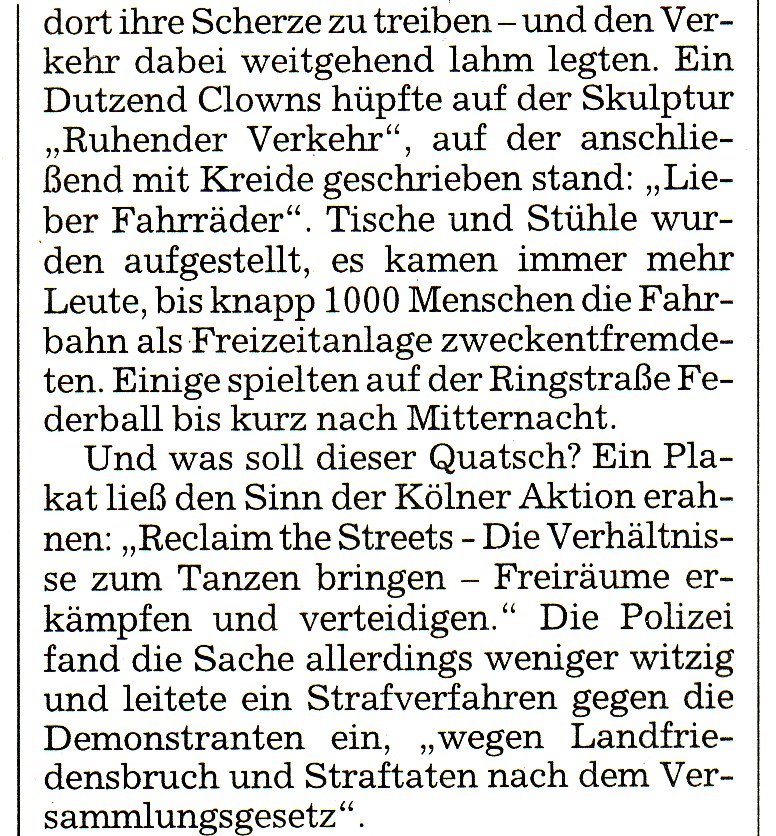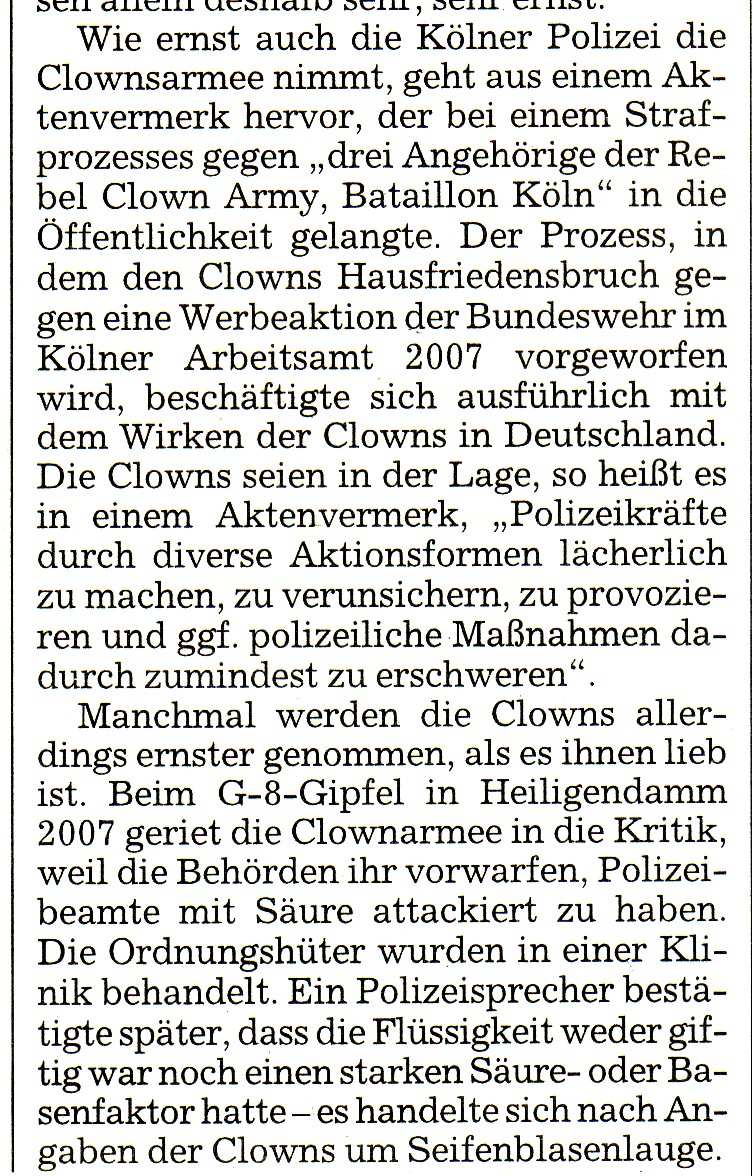 A "clown
army" artist A "clown
army" artist
Do these faces tell a lot?
Is this parody?
The following article is reproduced here for scientific
Politik mit Pappnase
By Titus Arnu
© by Suddeutsche Zeitung 2008 |
Mark Johnson and Eliza O. Campbell
A NEW BREAD & PUPPET
THEATER?
During the 1960s, many artists in
the U.S. and Europe joined the protest movement in the so-called Third
World and used their art in order to oppose the war in Vietnam.
It was then that some artists used emphatic and, as we later were forced to concede, overdone phrases, like 'Our words (or: our movies, our happenings, etc.) are our guns.' Of course, it revealed a sense of commitment. A necessity to take action, to become involved. Since the last decade of the 20th Century, artists all over the world are again waking up and leaving the ivory tower. Forms of street theater, happenings, fantastic and surreal actions do again surface, in new and specific ways, and they are again a means of making political statements. Art is becoming political again. In a new way, it is becoming meaningful again, as a form of artistic intervention. This is not to say that non-political art cannot be beautiful and meaningful. But it shows that for many artists, in situations they face today, to make beautiful works of art, to make beautiful films, to stage plays in a way that is aesthetically intriguing, is simply not enough. As in the 1960s, the artificial line that was invented to separate the 'professional,' that is to say, art-market oriented artists from 'self-styled' artists (or so-called amateurs) is being scrapped.(1) We all know that this line was always dear to bureaucrats, people from the IRS, and certain critics who have no idea what artistic involvement is about. The surrealists knew that in order to be a poet, you do not necessarily have to jot down lines of 'poetry.' Every sentence you speak can be poetry. Every single act of yours can be a poetic, surrealist act. For the surrealists, the quests for poetry, the miraculous and social change seemed inseparable. This stance has influenced the situationists later on. It influenced those who invented 'happenings.' Alan Kaprow, for instance. In Berkeley, in the mid 1960s, students appropriated happenings as a form of political action. They became political artists. They re-invented art. You have only to look at the photos of the young people who occupied Alcatraz at the time. The Young Lords. They re-invented art. Of course, another strand of political
street theater and political happening was in the tradition of Brecht,
rather than the surrealists.
We see the effects of this everywhere - from France, where groups of so-called 'sans papiers' have created their own forms of street theater to formulate their quest for justice, to the Philippines where forms of street theater and street happenings play a part in the popular effort to oust a corrupt and malicious president, in another people's revolution, comparable to the one that ousted the murderous Marcos. And now, to everyone's surprise, in Germany, a new movement of young amateurs and professionals inventing their own forms of street theater and happenings has surfaced. They are known as the "Clown Army" because it's the "Clown Army" concept they are inspired by, in various ways. In a way they follow in the footsteps of the political street theater of the 60s. Another Bread & Puppet Theater? Not quite. Just as much as history doesn't repeat itself, aesthetic forms are not re-emerging unchanging. They are an expression of a given socio-cultural situation, a specific time, its concrete needs. Today, to form a small ensemble of street theater artists would not be enough. It's better to have ad-hoc groups, as many as possible, forming as needed, all over the country. It's no longer necessary to have somebody in charge of an ensemble, or to develop a 'profile' as a 'great professional' actor. The opposition against globalization and neo-liberal politicians curtailing if not scrapping civil rights is getting wider, and many young artists are choosing to join a collective form of artistic action which has no need for 'stars' and 'big names.'(2) Instead of following old aesthetic recipes and striving for recognition as 'serious artists' (which is the traditional way of building careers in the world of theater), the need "to merge politics and art, poetry and protest" is felt by them and it becomes a driving force.(3) A German daily, the 'Suddeutsche
Zeitung', recently described a happening that young artists attached to
the concept of a 'Clown Army' staged in the Rhenanian city of Cologne,
a town which is also well-known because of the Cologne Art Fair. Happening
artists occupied a ring road circling the downtown section of the city,
focusing their action on a sculpture entitled 'Non-circulating traffic'
which became a non-verbal center of the happening. A central aesthetic
and political aspect of this happening was the quest to transcend the separation
between actors and the audience. The actors (or 'clowns' of a 'clown
army') succeeded to involve people from the neighborhood and pedestrians
passing the scene. Young and old people from adjacent buildings brought
chairs and table, and the ring road became the location of a neighborhood
'fest'. Not a commercialized 'October fest' but a festival of opposition
against traffic pollution, against decades of political cronyism in Cologne.
(In fact, some maintain that the Cologne city hall, a mess described here
as Koelsche Klungel, could perhaps be described as a kind of Tammany Hall...
and this regardless of the political affiliation of the mayor...) If this
political happening transcended the real of 'pure' art, it proved
nonetheless lively and inventive. And it was a success, considering the
fact that bystanders and
-- Regrettably, the police department in Cologne was not amused, as the Suddeutsche Zeitung noted. The same negative reaction to subversive
street art was typical of the authorities in the state of Mecklenburg Vorpommern
where 'clown army' artists targeted the G-8 meeting at Heiligendam.
In contrast to this show of force,
the young happening artists from the region, truly inspired by the 'clown
army' idea and joined by colleagues from other areas, chose an aesthetic
strategy of ridicule that mimicked, again and again, in ever new artistic
ways, the martial behavior of the heavily armed 'forces of order.' Their
artistic concept was a fantastic way of expressing different values, those
of civil disobedience, of pacifism, of peaceful protest. They produced
laughter and a sense of aesthetic relief. They certainly helped defuse
a situation where otherwise anger might have been vented by some protesters.
And they exposed the needlessly militarist show of force of the Merkel
administration as folly. In other words, their street art accomplished
what all great art accomplishes - it heightened awareness and it produced
comic relief; it sharpened the consciousness of many in the audience (both
among the protesters and the police), and it fascinated due to the aesthetic
imagination at work.
However, once again, the forces of order were not amused. In one instance, a clown had used soap bubbles, blowing them into the face of a police office. As the paper reported, an officer was "treated in hospital" because he was "attacked with acid" (mit Saure attackiert).(2) Apparently, the press release was part of a campaign of disinformation of the government, intended to influence public opinion. Interestingly, the police was later on forced to take back that assertion. The inspiring memory of what street art is capable of remains. The 'clown army' idea and those who have grasped its potential have produced a motivating example, and they have expanded once more the frontiers of art, just as the Bread and Puppet Theater did several decades ago. ________________________ (1) This was entirely in the vein of Surrealist predecessors. Hadn't Louis Aragon pointed out that "[a]rtistic skill is mummery that compromises all of human dignity"? See: Maurice NADEAU, The History of Surrealism, New York (Collier Books) 1967, p. 85 - And hadn't André Breton, in 1926, written that the surrealists "use [the] pen [...] without the slightest professional arrogance [...]" (Ibid., p. 245)? (2) This tendency to prefer anonymity to stardom and 'collective' or 'group' creativity to individual 'performances' is remarkable. As Maurice Nadeau notes with regard to the United States, they have "an important tradition of cranky eccentricity in the arts" that deserves to be called non-conformist, that is to say, not toeing the line of the dominant 'bourgeois' morality (or ideology). "But," Maurice Nadeau adds with regret, "with the exception of Gertrude Stein, the recluse strain was very strong in all of them; their hopes and hoaxes remained very individual affairs." (Ibid, p.31) - Isn't it a challenging idea that we could indeed place the 'Clown army' artists among the heirs of Gertrude Stein? And this even though her crankiness and her hoaxes were of a sort rather different from the strange ways and hoaxes of today's street artists? (3) A "Clown Army" artist, quoted by Titus Arnu. See Titus ARNU, "Politik mit Pappnase", in Suddeutsche Zeitung, May 10-12, 2008, p.12. (4) Hans H.Hofstatter described symbolic art as integrating "significant evidence[s] of contradiction" ("bedeutende Zeugnisse des Widerspruchs"), containing "elements ... which, resisting all attempts of repression," have accompanied Western (Christian) culture for centuries. As its other side, so to speak (the "Nachtseite" or aspect of night; the negation). And this, in modern times, from Hogarth (17th century) and Piranesi to the present. See Hans H. HOFSTATTER, Idealismus und Symbolismus, Vienna / Munich (Anton Schroll & Co.) 1972, p.5 - In fact, the symbolic street art of the new happening artists follows in exactly that vein, representing the other side (the negation) of official political culture and the art that kowtows to it. This art form expresses contradiction, it resists repression, it creates awareness of the repressive barriers of bourgeois politics and bourgeois moralism. It pokes fun at the contemporary despotism of the global economy and its major players and political clerks. (5)Titus ARNU, Ibid.
- |
 paramilitary police
paramilitary police
.jpg)







